#denarius of brutus
Note
Famous last words spoken by dictators:
Et tu Jar-Jar?
jar jar isn't a liberator, he's darth jar jar!! worst dictator of them all
#i mean unless he's killing dictators to take their power#which IS potentially brutus core! ides of march denarius of 43/42 bce im looking at u#thanks for the ask!
107 notes
·
View notes
Text
As the Ides of March approaches, I'd like to remind you that this coin exists.

Brutus issued this denarius to commemorate the assassination of Caesar. I love how the coin is like:
It is time to celebrate the #idesofmarch, guys! #stab #stab #hat
#the hat is a pileus which symbolizes liberty#but id like to think there was just some random hat on that ides of march coin#stab#hat#ancient rome#tagamemnon#brutus#cassius#gaius julius caesar#julius caesar#ides of march#the ides of march#roman history#pileus#ancient clothing#funny#roman coins#march 15#et tu brute
194 notes
·
View notes
Text
Thanks to the New York Metropolitan Art Museum for having one of these bad boys on display, or I would never have known how crazy Late Republican Rome actually got
8 notes
·
View notes
Note
Would you mind telling us more about pretender Brutus
Oh boy. @smiteblast442 you’ve really gone and done it now.
Cracks knuckles
SO
We all know this guy

Marcus Junius Brutus, of Shakespearean "Et tu?" fame, Roman politician and one of the leaders of the coup against Julius Caesar that took place on this site's favorite holiday. I really don't need to explain who he is or why he'd be a servant, but I'd love to see him in Fate as a way to hail in Rider Caesar or to at least finally give a serious story to Saber Caesar. This image in question is his denarius (basically a commemorative coin).
Except that's a lie. That was all a lie, in fact. That's not Brutus at all. Well, except, it is. But not Marcus Junius Brutus, nor his denarius. The famous denarius of Brutus would be THIS

The first coin in fact doesn't even have Brutus's head, it was that of a consul at the time who isn't remotely important to any of this. No, the first coin was minted by one Decimus Junius Brutus Albinus, the REAL leader of the coup against Caesar, and in many aspects the person many THINK Marcus was. Turns out, outside of Shakespeare Marcus wasn't that close to Caesar nor that important to the coup. Decimus, however, was both those things. There's this idea that Caesar saw Brutus as his own son, and that would be true...were it not people think that refers to Marcus. Caesar expressed both verbally and in writing on many occasions how he saw Decimus as his own son and possibly having formally adopted him. Caesar’s will even named Decimus as his second heir and guardian to any child of Caesar’s should he have left one behind. Not only did he know Decimus far longer than Shakespeare portrays Caesar and Marcus’s relationship, the real Caesar and Decimus were also even closer. What of the Shakespeare version IS accurate is that there were two key figures in the assassination of Caesar: Cassius, and [a] Brutus. In fact, it was Decimus who convinced Marcus to join the plot. And when Caesar had intended NOT to go to the forum due to his fear of the rumored conspiracy, who else but the man he saw as a son was arrived to put those fears at ease and convince him to attend that senate meeting? After the assassination, Marcus would in fact go on to be the one heralded as the usurper of Caesar, being a far better public speaker and quick to capitalize on a misconception that was present even at the time of the incident. But like in the rest of the story we all know, Brutus said a lot while doing nothing and achieved nothing of meaning as he trailed Cassius and both were eventually taken out of the picture by Antony (someone also particularly relevant to Fate Caesar btw...) meanwhile Decimus was made governor of Cisalpine Gaul but when he attempted to rendevouz with Marcus Brutus and Cassius as shit went down, he was intercepted by Gauls loyal to Antony and executed.
There's more to both Brutus' lives of course but those are the bits relevant to his status as a Pretender. This is not Marcus Brutus, this is Decimus Brutus living the role of both the man who betrayed Caesar and was later executed as the cycle of tyranny continued, and the naïve usurper who would be cornered into taking their life as they lamented their own idealism.
So, in other words, as a fate character the short version of their split identities are are that when he calls himself Brutus he’s Marcus and simply Decimius for his real self. Brutus is this "Oh woe is me, alas my friend Caesar" blah blah blah type always on about his unforgivable sin and wallowing in it but in a very disingenuous “look how noble I am” sense that is dripping with narcissism and hypocrisy, whereas Decimus is truly dead inside from the trauma that has amassed as he is forced further and further to live with the knowledge of what he did to a man who, no matter how tyrannical, thought him as much a son as Caesarion, and unable to ever forget the look in Caesar's eyes that day. He truly believed the ideals that Marcus was so quick to spurn when it suited his own rise to power, and thus had to live with the psychological consequences Marcus so easily skirted. Decimus is a man whose self worth died long ago and is now living for that ideal alone, willing to do whatever it takes to ensure the freedom of choice, even if it means giving up his own; I imagine he and Kerry would have a lot to talk about....
#fgo#fanservant#fanservant stuff#my writing#my ocs#pretender class#fgo pretender#writing shit#fgo caesar#he could also be a welfare pretender in the hypothetical Rider Caesar Summer event i've mentioned but that's moreso just a more realistic#way of implementing him given how fgo usually treats character implementation#i'd much prefer a 2 star pretender that reflects his actual strength or rather lack thereof and all the rest of the stuff that comes with th#*with it
11 notes
·
View notes
Text

Denarius minted by L. Plaetorius Cestianus in the summer or autumn of 42 BCE, from a military mint under the control of M. Junius Brutus and C. Cassius Longinus. The coin celebrates Brutus and Cassius' claim to have liberated Rome by assassinating C. Julius Caesar. On the obverse, the head of Brutus, identified as IMP(ERATOR); on the reverse, the pileus, a cap worn by freed slaves, between two daggers with the inscription EID(IBUS) MAR(TIIS) = "On the Ides of March". Photo credit: Classical Numismatic Group, Inc. http://www.cngcoins.com
#classics#tagamemnon#Ancient Rome#Roman Republic#ancient history#Roman history#art#art history#ancient art#Roman art#Ancient Roman art#Roman Republican art#coins#ancient coins#Roman coins#Ancient Roman coins#denarius#numismatics#ancient numismatics
276 notes
·
View notes
Text
I. NAMES
My cat, Brutus, has never harmed anyone. He mews
by the window, pawing at glass whenever he sees robins
hopping on the lawn and purging the earth
of worms. A perfectly docile companion. Much-loved
even by self-proclaimed cat-haters. You understand?
A normal cat.
But, see here. I brought a boy home once, a postgrad
who wore his high school wrestling hoodie and khaki pants,
who pet Brutus quite affectionately
until he learned his name. “Brutus?” he said,
and I confirmed. And he stared at the ground,
a shadow settling over his face.
I learned that during his undergrad there was an instructor
he fancied, who told him about the rare “Eid Mar” denarius.
That is, an ancient Roman coin commemorating the murder
of Julius Caesar. “Et tu, Brute?” He told me these things, stories
of a man long gone, who left him stranded
in life. Brutus, my funny, normal cat, heard all this, and
pressed his full weight against this stranger,
not really understanding his name’s significance,
not really caring.
12 notes
·
View notes
Text
The Ides of March Coin
The Ides of March Coin
The Ides of March coin, also known as the Denarius of Brutus or EID MAR, is a rare coin issued by the Roman Republic from 43 to 42 BC to celebrate the assassination of Julius Caesar on March 15, 44 BC.
One side features Marcus Junius Brutus, once a close friend of Cesar who, after becoming disillusioned with his autocratic behavior and polices, helped lead his assassination.
The other side…

View On WordPress
2 notes
·
View notes
Photo

[The Ides of March coin also known as the Denarius of Brutus or the EID MAR is a rare version of the denarius coin issued by Marcus Junius Brutus from 43 to 42 BC. The coin was struck to celebrate the March 15, 44 BC, assassination of Julius Caesar. It features a bust of Brutus, who was one of the assassins, on the obverse while the reverse features a pileus cap between two daggers. The coin was minted in both silver and gold. Approximately 100 of the silver coins are known to exist, but only three of the gold examples have survived.
Background
The coin was struck with the words EID MAR (short for Eidibus Martiis – on the Ides of March) to commemorate the assassination of Julius Caesar on March 15, 44 BC.[2] The assassin Brutus appears on the coin's obverse with a bust of him, looking to the right. The reverse of the coin displays a pileus cap flanked by two daggers. EID MAR appears on the reverse below the daggers to commemorate the assassination of Caesar during the Ides of March.[3] The pileus cap was a Roman symbol of freedom, and was often worn by recently freed slaves.[4] The daggers represent the weapons which were used to kill Julius Caesar.[5]
The minting of the coins took place between 43 and 42 BC, coinciding with the Liberators' civil war. The coins were struck by a "military mint" which traveled with Brutus.[6] The coins were ordered by Brutus and produced by Lucius Plaetorius Cestianus, possibly to pay Brutus' army.[7] The issuance of the coin suggests that the assassination was legitimized by the state, but it was not. The assassination of Caesar was not supported by the majority of Romans. The minting of the coin may also be a political statement or propaganda commissioned by the assassins of Caesar.[8] An interpretation of the coin's symbols is that the Roman state was liberated from slavery with the assassination of Caesar.[9]]
They made a coin of it! A fucking coin!
1 note
·
View note
Photo
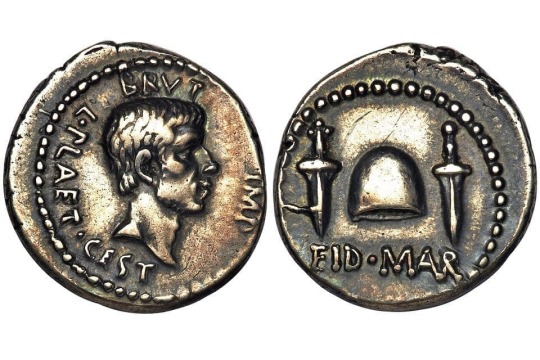
The Most Famous Ancient Coin: The Ides of March Denarius Sold for $546,250.00 A silver denarius struck by Julius Caesar’s assassin Marcus Brutus in 42 BC, celebrating the infamous deed that occured on March 15, 44 BC. https://www.instagram.com/p/B_JEDPFlvKY/?igshid=16rudzmdukc2x
175 notes
·
View notes
Photo
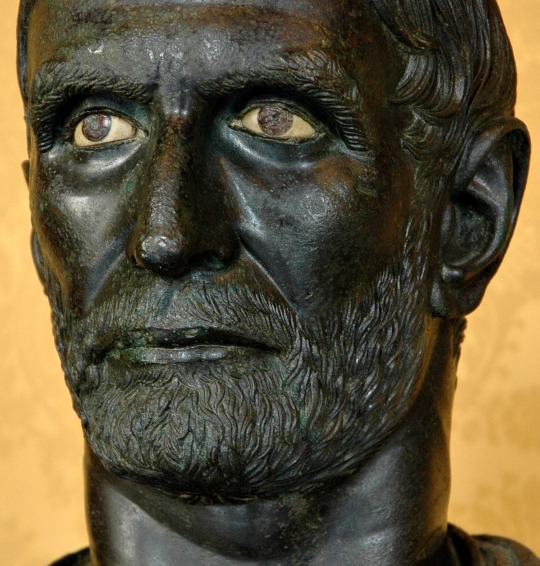
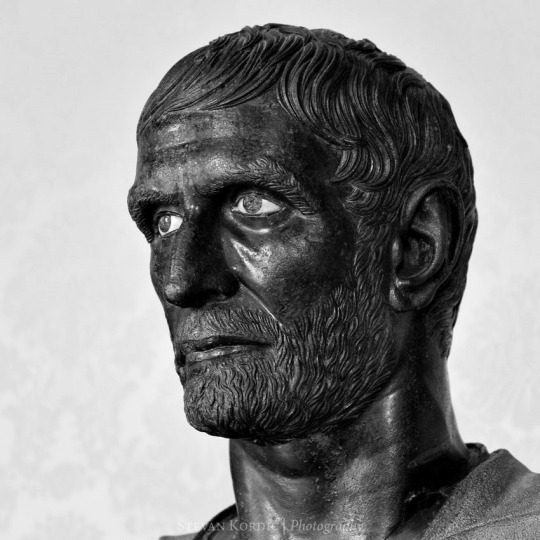
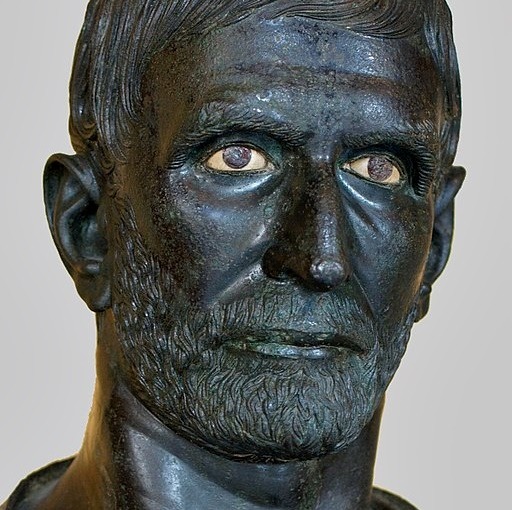
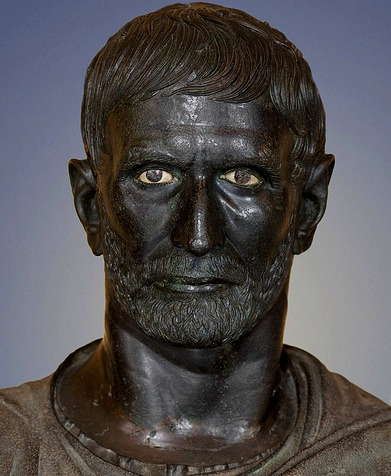
Capitoline Brutus
“The disagreement has not only been over the date of this piece, but also over the nationality of the bronze caster who made it and its identification as Lucius Junius Brutus, founder of the Roman republic. Known since the mid 16th century, the head sits on a base made during the Renaissance. It is the earliest Roman portrait in bronze that exists. And it bears a striking resemblance to images of Lucius Junius Brutus found on silver dinari, those Roman coins, of 54 BCE. Some scholars believe it dates to the later 4th century BCE, a time when Greek sculptors did realistic portraits of individuals while others place it closer in date to the denarius coin in the mid 1st century BCE. The stately look, the light beard, the thin hair strands seem to be Greek characteristics, but the resemblance to the Roman coin and the ultra realistic appearance tend towards Roman portraiture of the 1st century BCE.
The face has the suppleness and what is called plasticity of form, of Greek portraits. But viewed in a certain light it appears angular with simple geometric treatment of the neck and even the facial structure. The historical Brutus lived in the later 6th century BCE and was a hero of early Rome. And so, this work would have to be a fantasy creation in any case, a suggestion of what the early hero of the Roman republic should have looked like, rather than actually did. Did a later member of Brutus' kins or family pose for the portrait? Or is it a pure invention, just as the Romans created for their alleged founder/hero Aeneas, who was made to look like a bearded Zeus during the Augustan period?
Capitoline Brutus has not yet given up all its secrets. Its deep set ivory eyes inlaid with dusky blue glass. The diagonal brows. The sharp mouth with its drawn out full sets give the piece a strange, rustic charm. The contrast with the smooth and carefully done hair. Some scholars are convinced that it should be dated just this side of 300 BCE. But this opinion can change depending on the light shining on this piece and the angle at which it is viewed. It remains one of art history's most fascinating enigmas.” - David Soren
#i like this piece i like its mysteries and its so realistic its like a living real person bro staring at u#also i like his nose#history#art#tagamemnon#ancient rome#q
19 notes
·
View notes
Photo
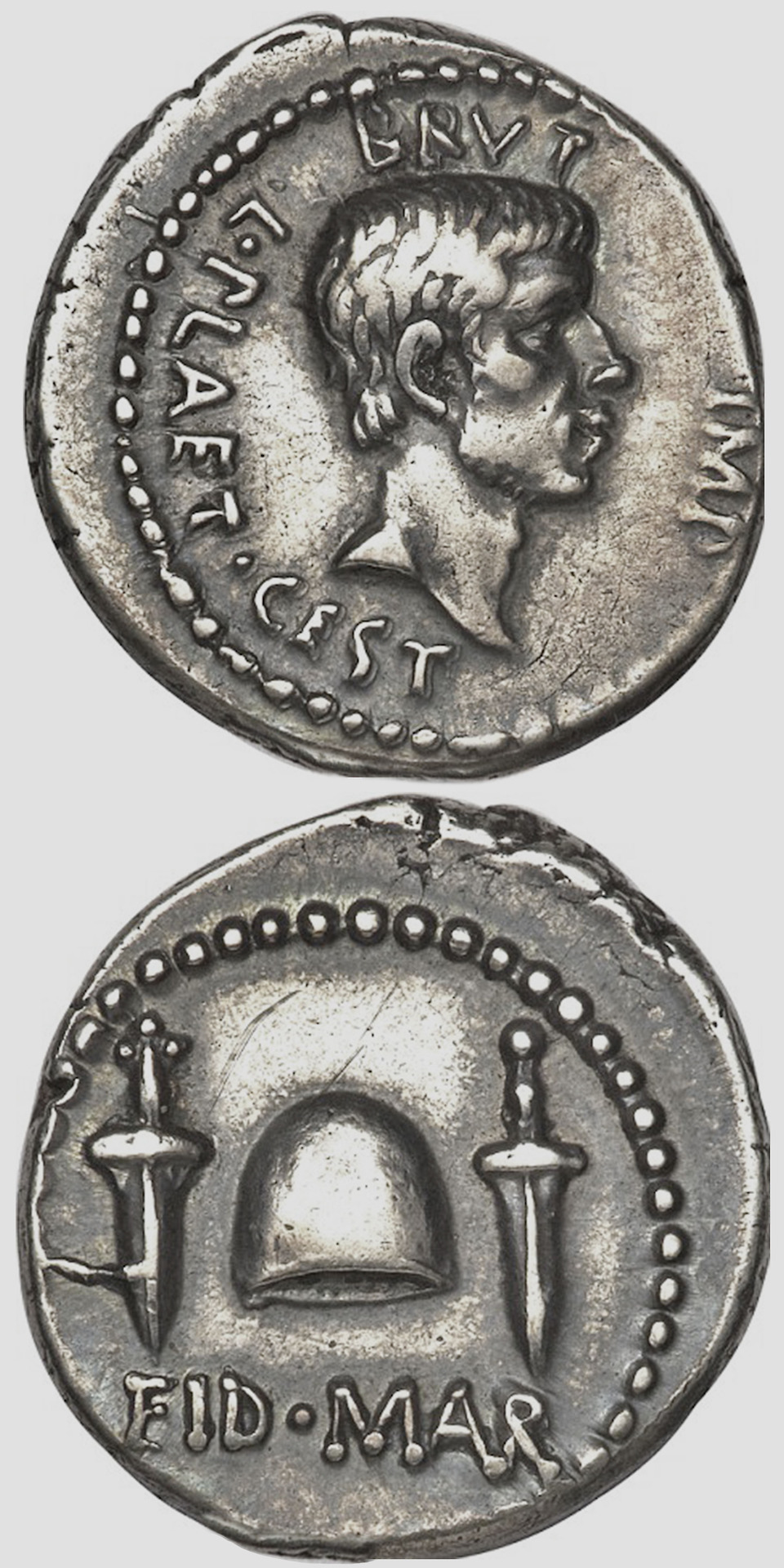
Denarius of Brutus with his portrait on the obverse (RRC 508/3)
The denarius of Brutus commemorating the assassination of Caesar is one of the very few coins to be described in the ancient literature. Cassius Dio relates that "Brutus stamped upon the coins which were being minted his own likeness and a cap and two daggers, indicating by this and by the inscription that he and Cassius had liberated the fatherland" (Roman History, XLVII.25.3). Minted in 42 BC, while Brutus and his fellow conspirators were on the march in northern Greece, the coin type was recalled by the victorious Mark Antony and Octavian and melted down. Approximately seventy-five examples are known to exist.
Image © The Trustees of the British Museum
#ides of march#if I have veil'd my look#brutus#julius caesar#cæsar#artefact#coin#roman empire#44 BC.#denarius#a soothsayer bids you beware the ides of march#shakespearean
20 notes
·
View notes
Text
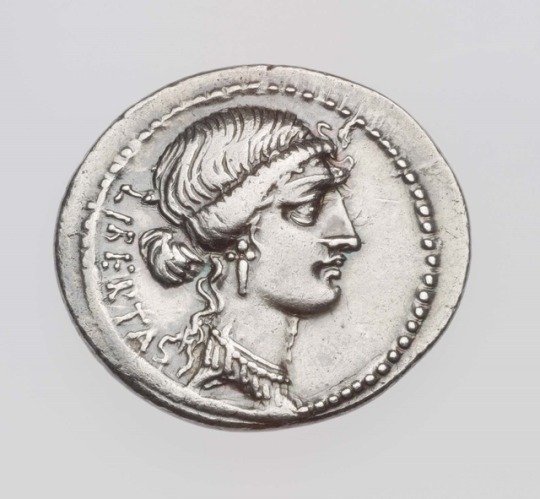
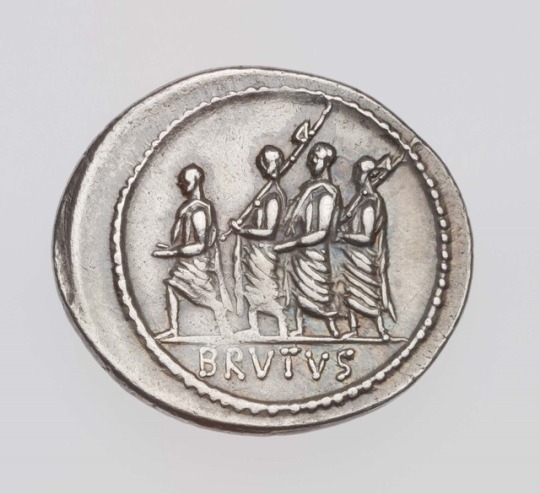
~ Denarius with bust of Libertas, issued by Q. Servilius Caepio Brutus.
Culture: Roman
Period: Late Republican Period
Date: ca. 54 B.C.
Mint: Rome, Italy
Medium: Silver
#ancient#ancient art#ancient currency#ancient coin#coin#currency#numismatic#denarios with bust of libertas#libertas#brutus#rome#italy#roman#silver#ca. 54 b.c.#history#archeology#museum
1K notes
·
View notes
Photo

Marcus Junius Brutus Denarius. Military mint moving with Brutus in Lycia, 43-42 BC. C FLAV HEMIC LEG PRO PR, draped bust of Apollo right, lyre before / Q CAEP BRVT IMP, Victory standing left, crowning trophy & holding palm. Junia 49, Cr504/1, Syd 1294. In honor of the day, a coin of Brutus, the man who killed Caesar on this day in 44 BCE.
298 notes
·
View notes
Text
BEWARE THE IDES OF MARCH AMERICA! MARCH 15,2019

What the ides of March can teach is today in our current situation:
“Beware the ides of March!” This expression is familiar to many of us because Shakespeare used it in his tragedy “Julius Caesar,” the Roman general and politician who was once the most powerful person in the world.
Its warning is one all Americans would do well to take to heart in today’s troubled and confusing times.
More Americans ought to think through how long we can tolerate disruptions to the functioning of our federal government, put off upgrading our aging transportation and water supply infrastructures, live with ever-widening gaps between the relatively few haves and the many have-nots, support an economically and humanly costly forever war on terrorism fought by one percent of our population, ignore the splintering of information so that there is no common basis for informed and respectful public debate and attribute our problems to immigrants, illegal and legal. We are calling out, with guidance from Shakespeare and Roman historians, “American citizens, beware the ides of March.”
This is no trivial matter, as we can see by using as an example Caesar himself, a savvy and courageous public figure and an accomplished military leader who makes Dwight Eisenhower, Lyndon Johnson, and Karl Rove look like amateur politicians.
In the second scene of Shakespeare’s play, during the public celebration of Caesar’s greatest triumph, a soothsayer — truth-teller — shouts out his warning from a tumultuous crowd. Caesar asks who this man is. Brutus, a close associate who we know will later help assassinate Caesar, explains the “soothsayer(truth-teller)bids you beware the ides of March.” Wanting confirmation, Caesar has the soothsayer brought face to face. We hear for a third time within seven lines of the play, “Beware the ides of March.”
Shakespeare wanted this warning to stay with us as we watch the political maneuverings of Caesar’s rivals and the miscalculations that the shrewdly intelligent Caesar makes that will soon cost him his life. But the self-serving actions taken by all of Rome’s leaders and by the people who supported their different factions would lead to increasing violence and bloodshed across the known world and, within a few decades, to the end of the Roman Republic.
Fifteen years earlier than the action of Shakespeare’s play, Caesar passed land-grant legislation designed to bring relief to Roman military veterans and the urban poor. As the University of Texas at Austin alumnus and historical writer Philip Freeman puts it, Caesar’s bill brought “enormous benefits to Roman citizens,” and it “cost the Roman treasury, not a single denarius.” The strong objections of old-guard Roman aristocrats against the bill and the political chicanery they used to try to block it were based on political self-interests and aimed at keeping Caesar from increasing his popularity and power base.
Caesar’s situation in 45 and 44 B.C. even in antiquity stood out as a case study of the pitfalls of power politics. After defeating his rival Pompey’s army at the Battle of Munda in Spain on March 17, 45 B.C., Caesar was named a dictator, a title given to a leader in times of emergency. He is at the height of his power and popularity. He is not about to have a soothsayer with no political power or economic influence affect his life with a prophetic warning. So, Caesar dismisses it: “He is a dreamer; let us leave him: pass.”
Caesar’s inattention cost him his life. One ancient source calculates that more than 80 conspirators were planning Caesar’s assassination. His opponents were senators who no longer ruled for the common good if they ever had. They were joined by those who had grown rich with the support of senators and other government officials. They wanted their power and prestige back. They assassinated Caesar three days before he was scheduled to lead the Roman army to wage war against the Parthians in what we now call the Middle East.
Our lives continue to suffer under complex problems that self-regarding political leaders refuse to solve. Let us at least heed on the Ides of March!!
IN MY OPINION, I GUESS SOME FOLK WILL NEVER LEARN WHO ARE IN POLITICAL POWER OF A GREAT NATION. HISTORY WILL REPEAT ITSELF AT SOME POINT THROUGH THE YEARS.
0 notes
Photo
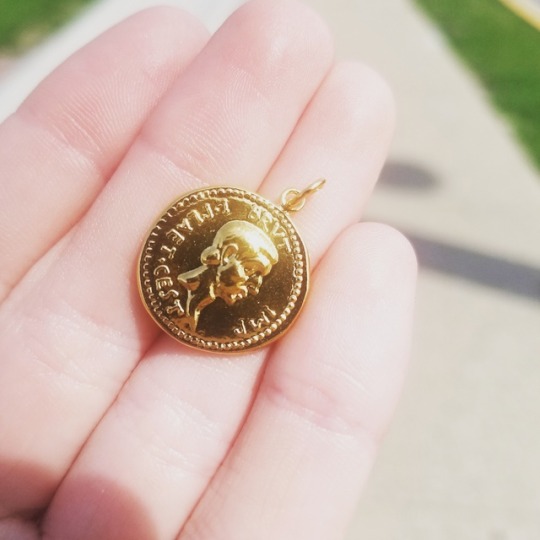
MY REPLICA BRUTUS DENARIUS CAME IN THE MAIL! Look at that honorable man 🔪💕🔪💕🔪💕🔪💕
22 notes
·
View notes
Text
What Rare Coins Will Be Popular In 100 Years?
Long-time collectors know that they will get the best results when they sell by acquiring coins and paper money that other collectors would desire. What that means is that attractive coins and currency have an edge over ones that are not. If you dig deeper, ones that are more attractive for the given grade than other pieces of the same technical condition will be easier to sell.
However, fads in collecting can and do change. In the early 1960s, the collecting of uncirculated rolls of US cents and nickels was popular, which out of favor today. Also back then, in US proof sets, the condition of the cent was key where today it is the half dollar.
However, if you review the entire history of coins and paper money, you can discern some clues of what will likely be popular one hundred years from now. Here are some of my thoughts.
Ancient coins, especially those issued by major historical figures, will always be popular. By major figures, I am referring to Alexander the Great in the Greek world as well as the Athenian “Owl” silver tetradrachms. In ancient Rome, there are a number of issuers such as Julius Caesar, Brutus, Marc Antony, Augustus, Nero, Hadrian, and Constantine whose coins will stand the test of time. From the Middle East, the coins with ties to the Bible will be in demand such as the Widow’s Mites, Shekels of Tyre, and the Roman Emperor Tiberius Denarius (the Tribute coin).
From the Byzantine Empire, gold coins issued by Emperors Anastasius and Justinian I (the Great) are likely to be among the most desired. From the early days of the Muslim empire, issues of the most famous rulers will stand out. Any issues of Genghis Khan or Kublai Khan will find demand.
Moving into the Middle Ages up to more recent coins, those issued by famous or notorious rulers from almost anywhere will have staying power. For just a few names, think of British Prince John (of Magna Carta fame), British King George III, issues of some of the more famous Holy Roman Emperors, French ruler Napoleon I, and any other people important in the history of a particular nation in which a collector has an interest. The Spanish colonial 8 Reales from the New World will be popular, partly because they formed the basis of the value of the original US silver dollar
The earliest paper money issues in history came from China. They will always draw interest.
As for American coins and paper money, I suspect the ones that will have the most enduring interest are those that depict the most famous Founding Fathers—George Washington, Benjamin Franklin (especially the paper money he printed), and Thomas Jefferson. The $20.00 Saint Gaudens will likely be popular because of its beauty. There is even the possibility that the coins and paper money featuring Abraham Lincoln could still be of interest a century from now.
What you may notice is that I’m not listing any current or recent coins or paper money. In my mind few, if any of them, are likely to stand the test of time for popularity.
This is a subject where every collector will have their own opinions. I’m sure there would be a wide variety of issues proposed. We’ll just have to wait one hundred years to know for sure which ones will be most popular, but it can be fun today to try to forecast the future.
Patrick A. Heller was the American Numismatic Association 2018 Glenn Smedley Memorial Service Award, 2017 Exemplary Service Award 2012 Harry Forman Dealer of the Year Award, and 2008 Presidential Award winner. He was also honored by the Numismatic Literary Guild in 2017 and 2016 for the Best Dealer-Published Magazine/Newspaper and for Best Radio Report. He is the communications officer of Liberty Coin Service in Lansing, Michigan and writes Liberty’s Outlook, a monthly newsletter on rare coins and precious metals subjects. Past newsletter issues can be viewed at http://www.libertycoinservice.com. Some of his radio commentaries titled “Things You ‘Know’ That Just Aren’t So, And Important News You Need To Know” can be heard at 8:45 AM Wednesday and Friday mornings on 1320-AM WILS in Lansing (which streams live and becomes part of the audio and text archives posted at http://www.1320wils.com).
The post What Rare Coins Will Be Popular In 100 Years? appeared first on Numismatic News.
0 notes